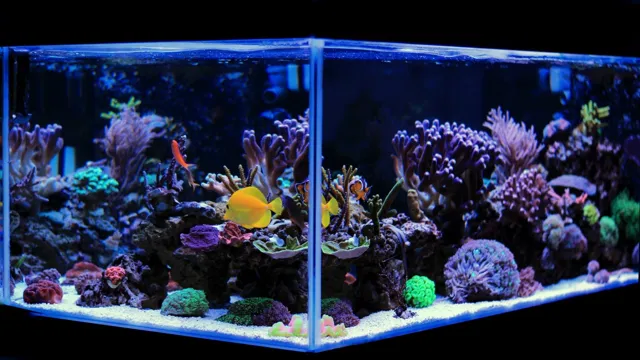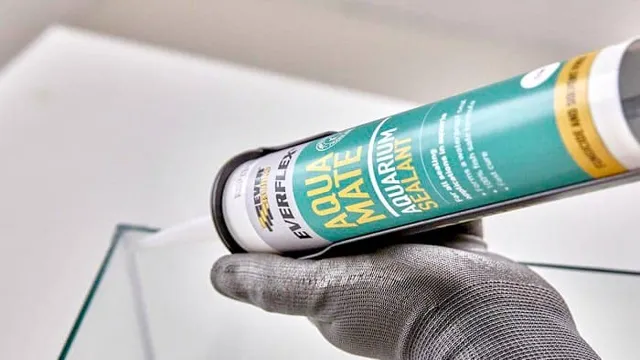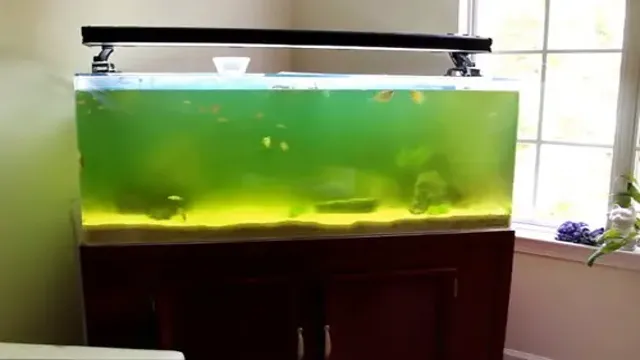Do you love the natural look of driftwood in your aquarium, but hate the brown tannins it leaves behind? Driftwood can be a beautiful addition to any aquarium, giving it a natural, rustic feel. However, those brown tannins that seep into the water can make it look dirty and uninviting. Don’t worry, though! There are easy ways to remove those tannins and clear up your aquarium water, without having to sacrifice the aesthetic of your driftwood.
In this blog, we’ll dive into the best practices for clearing driftwood tannins from your aquarium water, so that you can enjoy the benefits of this beautiful addition, without sacrificing the cleanliness of your tank.
Introduction
Driftwood is a popular addition to aquariums as it provides a natural and aesthetically pleasing environment for fish. However, it can also cause the water to become cloudy or discolored, which can be frustrating for fish enthusiasts. Fortunately, there are several ways to clear aquarium water from driftwood.
First and foremost, make sure the driftwood is thoroughly cleaned and boiled before adding it to the aquarium. This will help remove any unwanted debris or tannins that can discolor the water. Another option is to use a chemical filtration system, such as activated carbon, to absorb any impurities in the water.
Regular water changes and proper maintenance of the aquarium’s filtration system can also help keep the water clear and healthy. With a bit of effort and attention, driftwood can be a beautiful and enriching addition to any aquarium without compromising water quality.
Understanding Driftwood Tannins
Driftwood tannins are a common feature in aquariums, particularly those that contain fish and plants. These tannins are produced when wood in the aquarium begins to break down and leach tannins into the water. While some people find the yellowish-brown color of the water unappealing, driftwood tannins don’t harm fish and actually offer a number of benefits.
For example, tannins can help to lower the pH of the water, which can be beneficial for some species of fish. Additionally, tannins can have a natural antibacterial effect, which may help to keep your aquarium cleaner and healthier. Overall, while driftwood tannins can take some getting used to, they are an important aspect of a healthy and thriving aquarium.

Why Clear Tannins from Aquarium Water?
Aquarium enthusiasts are often plagued with cloudy or murky tank waters. One of the most common culprits of this phenomenon is tannins. While they are harmless and natural in the wild, tannins can alter the pH levels and colour of aquarium water, affecting the overall health of aquatic life.
For this reason, it is important to clear tannins from aquarium water. By doing so, we can create a clear, healthy, and vibrant ecosystem for our fish, plants, and other aquatic inhabitants. With the use of activated carbon and regular water changes, we can eliminate the effects of tannins and maintain a thriving aquarium environment.
Methods for clearing Tannins
If you’ve recently added driftwood to your aquarium, you may have noticed tannins released into the water. While harmless, these tannins can leave your aquarium with a yellow or brownish tint. Luckily, there are a few easy methods for clearing tannins from your aquarium water.
One way is to perform regular water changes, being sure to siphon out as much of the discolored water as possible. Another option is to use activated carbon, which can absorb tannins and other impurities in the water. Additionally, you can try boiling the driftwood before adding it to your aquarium, as this can help release some of the tannins beforehand.
By taking these steps, you can ensure that your aquarium remains clear and healthy for your fish and other aquatic life. (See Also: How to Make Aquarium in Little Alchemy 2: A Step-by-Step Guide)
Water Changes
When it comes to clearing tannins from your aquarium, there are a few methods that can help in the process. One effective way to reduce tannins is by performing regular water changes. The process involves removing a portion of the tank water and replacing it with fresh, clean water.
By doing this, you’re diluting the tannins and reducing their impact on the aquarium’s water quality. It’s recommended that you change around 20-30% of the tank water each week to keep the water chemistry balanced and make it less conducive for tannin production. Another effective method is by using activated carbon, which helps to adsorb the tannins and other impurities from the water.
By incorporating activated carbon into your aquarium’s filtration system, you can significantly reduce the appearance of tannins. Remember, regular maintenance is key to maintaining a healthy and vibrant aquarium, so stay on top of your fish tank care routine using these simple and effective methods.
Activated Carbon
Activated Carbon When it comes to clearing tannins from water, activated carbon is one of the most effective methods. Activated carbon works by adsorbing chemicals and impurities from the water, including tannins, which can cause water discoloration and an unpleasant taste. This type of carbon is produced by heating carbon-rich materials like coconut shells or wood to high temperatures, creating pores that are extremely effective at trapping and removing impurities.
When water is passed through activated carbon, the tannins bind to the surface of the carbon, filtering the tannins out of the water. The end result is clean, clear and great-tasting water. Activated carbon filters generally need to be replaced after a certain period of use, depending on the water quality and frequency of use.
In addition, activated carbon can be used in combination with other methods like reverse osmosis or UV sterilization for even more effective water purification.
Boiling Driftwood
Boiling Driftwood Boiling driftwood is an effective method for clearing tannins from the wood. This process involves boiling the wood in water to remove the tannins that cause discoloration and can be harmful to aquatic life in aquariums. To begin, prepare a pot of water and place the driftwood inside.
It’s important to note that the water will turn brown as the tannins are released from the wood, so be sure to use a pot that can be easily cleaned. Keep the wood submerged in the boiling water for about an hour, periodically checking the water’s color and adding more if needed. Once the water stops turning brown, that’s a good indication that the tannins have been removed from the wood.
Remove the driftwood from the pot and let it dry completely before adding it back into the aquarium. Boiling driftwood is a simple and effective way to clear tannins from the wood and make it safe for aquatic inhabitants.
Preventing Tannin Buildup
Driftwood is a popular addition to aquariums. However, it can cause tannin buildup, which leads to discolored water. The good news is that there are ways to prevent tannin buildup in the first place.
One way is to soak the driftwood in water for several days before putting it in the aquarium. This will help leach out some of the tannins. Another way is to boiling the wood for a few hours. (See Also: How to Cycle a Tropical Fish Aquarium: A Complete Guide for Beginners)
This process can help remove a lot of the tannins quickly. Using activated carbon in the aquarium filter can also help absorb tannins and keep the water clear. Remember to keep up with regular water changes and maintenance to keep your aquarium healthy and clear.
By following these tips, you can enjoy the beauty of driftwood in your aquarium without having to deal with discolored water.
Choosing Driftwood
When choosing driftwood for your aquarium, it’s important to consider how to prevent tannin buildup. Tannins are organic substances that seep out of the driftwood, turning the water a yellowish-brown color. While tannins are natural and harmless, they can be unsightly and may affect the pH levels in your aquarium.
One way to prevent tannin buildup is to soak your driftwood before adding it to your tank. Soaking the wood in hot water for 24 to 48 hours will help to release any excess tannins. You can also boil the driftwood to remove tannins more quickly, but boiling may cause the wood to break down and release harmful substances.
It’s important to choose driftwood that is safe for aquarium use and has been properly treated to avoid any harm to your aquatic pets. By taking these precautions, you can enjoy the beauty of driftwood in your aquarium without worrying about tannin buildup.
Soaking Driftwood Before Adding to Tank
If you’re planning on adding driftwood to your aquarium, it’s important to soak it beforehand to prevent tannin buildup. Tannins are organic compounds that are released from the wood and can cause the water to turn yellow or brown. Soaking the driftwood will help to reduce the amount of tannins that are released into the water.
The process of soaking will also help to remove any dirt or debris that may be on the wood. To soak the driftwood, you’ll want to fill a container with water and leave the wood in it for a few days. Use hot water to speed up the process if necessary.
Once it’s done soaking, give the driftwood a good rinse before adding it to your tank. This simple step will ensure that your aquarium remains clear and healthy for your aquatic inhabitants.
Limiting Direct Sunlight on Tank
If you’re constantly seeing tannin buildup in your aquarium, it could be due to too much direct sunlight. While natural light is important for aquatic plants, algae growth and tannin buildup can occur if there’s too much sun. To prevent this, it’s important to limit the amount of direct sunlight that your tank receives.
You can do this by placing your aquarium in a more shaded location or adding some curtains or blinds to filter the light. Not only will this help prevent tannin buildup, but it will also help regulate the water temperature and prevent excessive algae growth. So, don’t be afraid to get creative with how you shade your aquarium – your fish and plants will thank you for it!
Conclusion
Clearing aquarium water from driftwood can be a daunting task, but fear not, my fishy friends! By following our tips and tricks, you can say goodbye to murky water and hello to a crystal clear tank. Just remember to soak your driftwood before adding it to your aquarium and perform regular water changes to keep those pesky tannins at bay. With a little patience and persistence, your tank will be the envy of all your aquatic acquaintances. (See Also: How to Clean a Moss Ball in Aquarium: An Easy and Effective Guide)
So don’t be afraid to drift towards a clearer future in your underwater oasis!”
FAQs
What causes aquarium water to turn brown when using driftwood?
Driftwood releases tannins which can cause the water to turn brown.
How can I prevent driftwood from discoloring my aquarium water?
Soak the driftwood in a bucket of water for several days before adding it to the aquarium or use activated carbon to absorb the tannins.
Will boiling driftwood before adding it to the aquarium help clear the water?
Yes, boiling driftwood can help remove excess tannins and prevent discoloration of the water.
Can I use chemical clarifiers to clear up my aquarium water from driftwood?
Yes, but it is not recommended as it may harm the fish and other aquarium inhabitants. Using natural methods such as activated carbon or regular water changes is a better option.
How often should I change the activated carbon in my aquarium to prevent water discoloration from driftwood?
Activated carbon should be replaced every 4-6 weeks or as recommended by the manufacturer to ensure optimal performance.
Is it safe to add more driftwood to an aquarium with already discolored water?
It is not recommended to add more driftwood to an aquarium with already discolored water. Wait until the water clears up before adding more driftwood.
Can certain types of driftwood clear up aquarium water instead of causing discoloration?
Yes, some types of driftwood, such as Malaysian driftwood, can help clear up cloudy water by releasing natural antibacterial properties.







